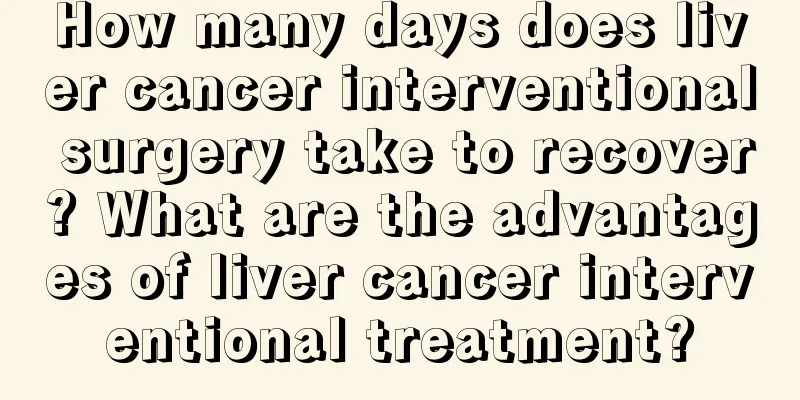How many days does liver cancer interventional surgery take to recover? What are the advantages of liver cancer interventional treatment?

|
Liver cancer has become one of the major diseases that endanger society and human health. Interventional therapy is a common and effective method for treating liver cancer. How many days does it take to recover from liver cancer interventional surgery? 1. How long does it take to review after liver cancer interventional surgery? After interventional treatment for liver cancer, follow-up examinations are conducted monthly at first, then every three months, and then every six months. After interventional treatment for liver cancer, in addition to active follow-up examinations, rehabilitation and follow-up treatment are also required. After surgery, patients are encouraged to eat as soon as possible, especially drink water. At the beginning, they can eat a low-salt, low-fat, vitamin-rich, and easy-to-digest diet, and gradually transition to a normal diet, eat more fresh vegetables and fruits, keep bowel movements smooth and intestines clear, reduce intestinal bacterial reproduction and production, and promote recovery. How long after interventional treatment for liver cancer should the follow-up examination be given? 3-5 days of infection prevention drugs, 5-7 days of liver protection treatment, and 5-7 days of methylprednisolone should be given to reduce post-embolism reactions. After interventional treatment of liver cancer, there are symptoms such as nausea, vomiting, abdominal distension, and fever (37.5-38.5℃), which is called post-embolism cold syndrome. It is caused by vagus nerve excitement caused by embolism reflex and tumor necrosis absorption, and can usually be relieved and disappeared on its own. Apply pressure bandage to the femoral artery puncture site for more than 8 hours, and closely observe whether there is bleeding at the puncture site and pressure bandage dressing, and pay attention to whether the lower limb on the puncture side is cold or the dorsalis pedis artery pulsation is weakened. 2. Advantages of interventional treatment for liver cancer 2.1. The therapeutic effect is definite. Successful treatment can show a rapid decrease in AFP, reduction in tumor size, and relief of pain. 2.2. Scientific Mechanism: The local drug concentration of interventional therapy is dozens of times higher than that of systemic chemotherapy, and it blocks the blood supply to the tumor. Therefore, the two-pronged approach has good efficacy and less toxicity than systemic chemotherapy. 2.3. The operation is simple, easy, safe and reliable. 2.4. The elderly, the weak, and those with certain diseases can also undergo the procedure without general anesthesia and they only need to stay awake. 2.5. The cost is relatively low. 2.6. It can be repeated, and the diagnostic imaging is clear and easy to compare. 2.7. For some liver cancers, the size can be reduced and then resected in two steps. 3. Disadvantages of interventional treatment for liver cancer 3.1. Liver cancer mainly relies on the hepatic artery for blood supply, but the cancer mass is surrounded by the portal vein, so cancer cells can "survive in peace". 3.2. The operation is somewhat difficult. The catheter should be placed in the blood supply artery in a super-selective manner to achieve the best effect. However, sometimes it is difficult to enter the hepatic artery. However, some liver cancers can be supplied by multiple blood vessels. 3.3. Despite super-selective entry, there are still obvious side effects. According to data analysis, the most common reactions are in the gastrointestinal tract. 3.4. Patients with portal vein tumor thrombus should consider removing the tumor thrombus as appropriate. 3.5. Normal liver cells are still damaged, and a few patients even suffer from liver dysfunction. 3.6. Some patients’ blood vessels become blocked after one treatment, making further operations difficult. Which liver cancer patients can choose interventional treatment 1. Patients with primary or metastatic liver cancer who are considered unresectable for various reasons, or patients with small liver cancer who do not accept surgical resection. 2. Through interventional treatment, liver cancer can be reduced in size, making surgical resection easier and preparing for surgery. In addition, interventional treatment and subsequent surgery can reduce the spread and recurrence of the tumor. 3. Patients with incomplete liver cancer resection, postoperative recurrence or failure of other treatment methods. 4. For patients with ruptured and bleeding liver cancer lesions, interventional treatment can stop bleeding immediately and kill the lesions at the same time, and the risk is lower than that of surgical operation. 5. Patients without severe damage to liver and kidney function. 6. Patients without severe jaundice and ascites. 7. The patient's general condition is good and he has no serious bleeding diseases. |
>>: Is a red nose a sign of liver cancer? What are the common symptoms of liver problems?
Recommend
What is the reason for a thick and enlarged tongue
For every living thing, whether it is us humans o...
What is the correct way to wear a mask
With the improvement of people's living stand...
Is nail polish harmful to the body?
Now the nail industry is becoming more and more p...
What is the best treatment for gallstones
When it comes to gallstones, most people think th...
What's causing the pain on the right side of my head?
The headache on the right side is what we call mi...
In addition to coughing, what other characteristics are there in the early stage of lung cancer? Pay more attention to these three points
Many people know that lung cancer will cause pati...
How to care for small cell lung cancer
How should small cell lung cancer be cared for? S...
What tea can clear away heat, detoxify and reduce internal heat? These are the best choices
Today's office workers spend most of their ti...
The difference between kidney beans and French beans
We always confuse the distinction between many fo...
What is the difference between soap powder and laundry detergent?
Soap powder and laundry detergent are both very c...
How often should I wash my hair with Platycladus orientalis leaves
There are many functions of Platycladus orientali...
What happens if you don't eat during your period
Menstruation is the main time for weight loss. I ...
A small piece of the tooth broke off
Teeth are not only our appearance, but also have ...
Advantages of MRI in diagnosing cervical cancer
Cervical cancer is a common gynecological maligna...
Skin care during breastfeeding
There are many common skin care products in life....









